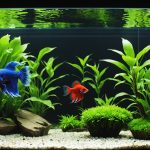Essential Setup Guidelines for Betta Fish
Creating an ideal Betta fish setup involves understanding their specific needs for a supportive environment. This begins with selecting the right tank. Betta fish thrive in tanks that are a minimum of 5 gallons. Smaller containers might not maintain the necessary water stability, affecting your Betta’s health. While the tank’s shape can vary, rectangular tanks offer better swimming room compared to round or vase-like shapes, further supporting a healthy lifestyle for these tropical fish.
Water parameters are crucial for a tropical fish habitat. The water temperature should be maintained between 76-82°F to mimic their native environment, with a pH level between 6.5 and 7.5 being optimal. Regular testing of these parameters is vital for the wellbeing of your Betta.
This might interest you : Top strategies to safeguard your pet from uk heatwaves: essential tips for every pet owner
For initial setup, key equipment includes:
- A heater to maintain consistent water temperatures
- A filter suitable for your tank size
- A lid to prevent jumping
Additionally, choose gentle filtration systems, as Betta fish prefer calm waters. Without these essentials in place, your Betta can experience stress, leading to decreased lifespan. By following these setup guidelines, you’ll ensure a healthy, nurturing environment for your Betta fish.
Topic to read : Essential Care Tips for Keeping Your Sphynx Cat Comfortable in Chilly British Weather
Recommended Water Parameters
When it comes to Betta fish care, ensuring optimal water quality is paramount for your fish’s wellness. The recommended temperature range for Betta fish is between 76°F and 82°F. This range helps maintain their metabolic health and comfort, ensuring longevity and vividness in colour. A stable environment also alleviates stress and susceptibility to diseases.
The ideal pH level for a healthy tank should be between 6.5 and 7.5. This pH mirror’s the natural habitat of Betta, promoting better adaptation. Alongside, the water hardness should remain moderate, ideally between 3 and 5 dGH. This balance ensures essential minerals don’t exceed or diminish, maintaining the overall robustness of the fish.
Regular water testing is crucial for maintaining these parameters. With this practice, potential imbalances can be identified early, and necessary adjustments can be made. Invest in a reliable aquarium test kit to monitor the conditions vigilantly. Adjusting and stabilising water parameters being an ongoing process, test frequently. Such diligence not only secures the environment’s health but also augments the beauty of your Betta fish. In conclusion, keeping an eye on water conditions is a foundational aspect of maintaining happy and healthy Bettas.
Choosing the Right Tank Size
When it comes to ensuring optimal fish welfare and activity levels, selecting the appropriate Betta tank size is of utmost importance.
Minimum Tank Size Recommendations
For a single Betta, the minimum recommended aquarium dimensions are usually a 5-gallon tank. This size provides enough room for swimming and prevents stress. Keeping multiple Bettas in the same tank requires careful consideration of tank size, at least 10 gallons or more. It is crucial to ensure the tank includes plenty of hiding spots to reduce aggression and maintain harmony among fish.
Impact of Tank Size on Betta Behavior
The size of the tank directly affects Betta’s behavior, influencing both activity and stress levels. In a cramped environment, Bettas may become lethargic, exhibit stress-related behaviors, and experience compromised health. A larger tank allows Bettas to exhibit natural behaviors, promoting physical health and emotional stability.
Benefits of Larger Tanks for Betta Fish
Opting for larger tanks brings significant advantages such as improved filtration and water stability. Bigger tanks can house stronger filters, which support better water quality by efficiently removing waste. Additionally, larger volumes of water help stabilize temperature and pH levels, ensuring a healthier environment. Better water conditions lead to vibrant, active Bettas, enhancing overall fish welfare and longevity.
Suitable Plants and Decorations
Creating a natural habitat setup for Betta fish isn’t just an aesthetic choice—it’s crucial for their well-being. The use of Betta fish plants can greatly contribute to a healthier and more engaging environment. Live plants like Java fern, Amazon sword, and Marimo moss balls are among the best options. They help in maintaining water quality by absorbing nitrates, providing shelter, and mimicking the Betta’s natural surroundings. If looking for artificial plants, those that are silk rather than plastic are preferable, as they prevent delicate Betta fins from tearing.
Aquarium decorations enhance the space, offering entertainment and security to Betta fish. Choose decorations that don’t have sharp edges or toxic paints. Rocks, driftwood, and caves can serve as ideal choices. These enrich the Betta’s environment, promoting exploration and preventing boredom.
Adding hiding spots is essential for Betta fish. These spots offer them relief from stress and a feeling of security, positively affecting their behavior. Happy Betta fish often display vibrant coloration and more active swimming patterns.
Incorporating a thoughtful mix of plants and decorations ensures that the Betta fish tank not only resembles their natural habitat but also supports their mental and physical health.
Filtration Options for a Healthy Tank
When deciding on aquarium filtration for your Betta fish, choosing the right filter type is crucial for their wellbeing. Balancing proper filtration while preventing strong currents can help provide a safe and comfortable environment for your fish.
Types of Filtration Systems
Understanding the range of available filter types is essential. Common systems include:
- Sponge filters, which offer gentle filtration ideal for Betta tanks, using air pumps to move water without creating strong currents.
- Internal filters, versatile and compact, offer efficient filtration but require careful adjustment to avoid turbulent water.
- Hang-on-back filters provide excellent water quality but may require baffle modifications to reduce flow strength.
Selecting Betta-safe Filters
It’s vital to choose Betta-friendly filters to protect your fish from stress caused by strong currents. Inspect the filter’s design and consider adjustable flow settings or baffles that can be installed to reduce water movement. Always test various settings to identify what best suits your Betta’s environment.
Maintenance of Filtration Systems
Maintaining your aquarium filtration system ensures its effectiveness and longevity. Regular checks to remove debris and clean filter media are necessary without disrupting beneficial bacteria. Aim to rinse parts gently in tank water to preserve the ecosystem balance. This routine will support a healthy, thriving Betta.
Maintenance Routines for Optimal Tank Health
Regular betta fish maintenance is essential for ensuring a healthy and thriving environment. Establishing a consistent routine for water changes and tank cleaning not only enhances the fish’s lifespan but also bolsters their overall well-being. A recommended schedule involves performing a partial water change of 25% to 30% weekly. This practice helps in maintaining the aquarium’s clarity and reduces harmful ammonia and nitrite levels.
When it comes to routine care, it is crucial to carefully monitor both the fish and the water quality. Regularly checking parameters such as pH, temperature, and nitrate levels aids in sustaining a balanced ecosystem. Observing any changes in behaviour or appearance in your betta can also act as an early warning system for potential health issues.
Common mistakes in aquarium upkeep include overfeeding and neglecting equipment maintenance. Overfeeding can lead to food debris and increased waste, causing water quality problems. Additionally, failing to clean filters and other aquarium parts can compromise the system’s efficiency. By adhering to these maintenance tips, you create a more hospitable habitat for your bettas and contribute to their vibrant health and energy. Always aim for stability in their environment, as abrupt changes can be detrimental to their thriving existence.
Visual Aids and Step-by-Step Instructions
In the aquarium setup guide, visual aids are indispensable. They offer clarity and enhance understanding, particularly when setting up a habitat for a Betta fish. Images, diagrams, and videos of tank arrangement help ensure each component is correctly placed, a necessity for maintaining a healthy environment.
Step-by-Step Guide on Setting Up a Betta Tank
Setting up a Betta tank involves several stages:
-
Choosing the Right Tank: Betta fish thrive in spacious habitats, so choose a tank that’s at least 5 gallons.
-
Installing a Filter and Heater: These ensure the water remains clean and at an optimal temperature.
-
Adding Substrate and Decorations: Provide a natural setting with gravel and safe plants or ornaments for your Betta to explore.
-
Filling with Treated Water: Use dechlorinated water to fill the tank, mimicking the Betta’s natural habitat.
-
Cycling the Tank: Establish beneficial bacteria for a stable environment before introducing your fish.
For those who wish to delve deeper into Betta fish care, the use of instructional visuals and a detailed Betta fish care guide can significantly bolster the learning process. Tutorials often offer precise steps and troubleshooting tips, ensuring the wellbeing of your aquatic companion.
Common Mistakes to Avoid when Setting Up a Betta Tank
Setting up a Betta fish tank can be rewarding, yet fraught with challenges. Many beginners stumble into familiar traps, unaware of the cascading effects on their aquatic pets. One prevalent betta fish setup mistake is choosing an inadequate tank size. While a small fish, Bettas need space; their tanks should ideally not be less than five gallons. Insufficient space can lead to stunted growth and stress—common pitfalls that can encompass poor health outcomes.
Misunderstandings about water quality often plague new Betta enthusiasts. Ignoring proper filtration systems or neglecting routine water changes can introduce harmful toxins into the environment. Filtration is crucial, not just for maintaining cleanliness, but for ensuring a stable ecosystem where Bettas thrive. Inadequately managed tanks frequently suffer from ammonia spikes and unstable pH levels, leading to the need for urgent aquarium troubleshooting.
Another significant error is selecting unsuitable tank mates for Bettas. These fish are territorial and may become aggressive if housed with species that provoke or crowd them. Poor choices in companionship can lead to stress and physical harm for all aquatic inhabitants. Providing Bettas with a suitably spaced tank with compatible mates helps promote a peaceful and thriving environment.











